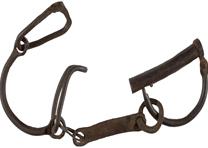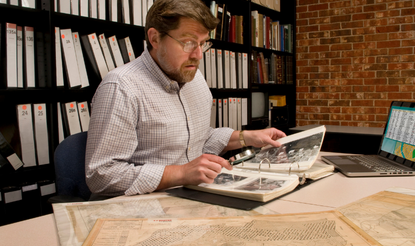The Material Culture of Slave Resistance
by Douglas R. Egerton
 Artifacts tell stories. Sometimes the tales are unclear or even contradictory, and sometimes artifacts—not unlike a dishonest diarist—can even lead the unwary historian astray. But the material culture of enslaved Americans, from buttons and beads to hammers and weapons, can often reveal as much to modern scholars as the written word. Especially for those people known as the "historically inarticulate," working men and women who did not bequeath us a Jeffersonian cache of thousands of letters to peruse, tangible material remains are often all that historians or archaeologists have at their disposal as they seek to reconstruct the lost world of the American past. An almost endless supply of documents from a master’s big house can tell us about the planter class, but other kinds of information can help us to understand how African Americans built their homes, cooked their food, dressed themselves, and on occasion, resisted their enslavement by picking up a sword.
Artifacts tell stories. Sometimes the tales are unclear or even contradictory, and sometimes artifacts—not unlike a dishonest diarist—can even lead the unwary historian astray. But the material culture of enslaved Americans, from buttons and beads to hammers and weapons, can often reveal as much to modern scholars as the written word. Especially for those people known as the "historically inarticulate," working men and women who did not bequeath us a Jeffersonian cache of thousands of letters to peruse, tangible material remains are often all that historians or archaeologists have at their disposal as they seek to reconstruct the lost world of the American past. An almost endless supply of documents from a master’s big house can tell us about the planter class, but other kinds of information can help us to understand how African Americans built their homes, cooked their food, dressed themselves, and on occasion, resisted their enslavement by picking up a sword.
The African American Burial Ground
Perhaps the one of the best examples of how scholars can use material culture to help recover the past is the artifacts discovered in New York City in 1991. As construction workers excavated a building site, they uncovered the remains of roughly 400 slaves, some of them Africans. The way any society mourns its dead always says much about its values, but the bones interred nearly 200 years ago reveal far more than the grief of loved ones. Most of the bones, for example, indicate the hardships faced by the black men and women who labored in post-Revolutionary Manhattan, a port that was then the second most demographically black city in the early Republic. (Only Charleston had a larger percentage of black residents.) Half the bones were from teenagers, and many more displayed torn ligaments, enlarged muscles, and even broken neck bones. Brass buttons, shoe buckles, and ceremonial objects also disclosed what written documents from the 1790s rarely do: how slaves dressed, what sort of shoes they wore, and how African spirituality survived the long passage to the Americas.
The material culture of slave life often exposes what written documents obscure. It enables historians to paint a more complete picture of the slave community—especially that part of slave life hidden from the master—by searching for evidence of what, say, slaves ate, or even what sort of dolls they crafted for their daughters. Those of us who write about slave rebellions typically have less need for such artifacts, since enslaved Americans who ran afoul of the law inadvertently created the sort of paper trail that historians always hope to find: newspaper reports, court documents, and written commentary about the event from judges, mayors, governors, and even presidents. Nevertheless, artifacts and material culture can enrich the study of topics usually examined through written documents.
Gabriel’s Rebellion, 1800
Although written documents—letters, wills, government papers—are customarily treated as sources that are qualitatively distinct from material culture, in some cases they may be treated as artifacts because of how they appear, rather than what the words on the parchment actually say (text of the evidence of Solomon at the Library of Virginia). In this case a slave named Solomon is on trial for the crime of conspiracy and insurrection. On the face of it, the case appears simple. Solomon, the brother of the slave rebel Gabriel, had been arrested in early September 1800 just outside of Richmond, Virginia, and several other slaves who lived on the plantation of Thomas Henry Prosser provided testimony against him. Yet in the same way that a discarded animal bone can tell us about the diet of a man like Solomon, this brief document may be deconstructed so that it speaks volumes about black rebelliousness, Virginia law, and strategies of survival on the part of the enslaved.
As a classroom exercise, have your students read this document. Contemporary court cases with high visibility usually capture the public’s imagination, and that was true as well in the early national period; future Attorney General William Wirt reported that he had to "fight" his way into the Virginia courtroom to watch the trials of Solomon and Gabriel. Students should read this document for content, but ask them also what they see, just as if they are examining tobacco pipes excavated from a Virginia slave cabin. Several slaves testified against Solomon, but in whose handwriting are the depositions? Under what conditions are men like Daniel and Toby providing testimony? Would we today call them hostile witnesses? Even if they are telling the truth, can modern readers regard as legitimate the testimony provided by terrified, enslaved men before a court of powerful, vengeful whites? Ask your students to gauge the length of the trial based upon this document (and most likely, this was the entire court proceeding in Solomon’s case). Twenty-first-century Americans are accustomed to celebrity trials that last for months. What does such a short artifact indicate about the sort of justice meted out by southern courts to rebellious bondmen?
One reason to study the material culture of any society is to draw a richer image of what everyday life was like in years past. For example, the elaborate buttons and elegant buckles excavated at Poplar Forest, one of Thomas Jefferson’s plantations, suggest that some slaves had access to the larger market. In the same way, ask your students to use Solomon’s trial record to recreate slave life away from the quarters. What did enslaved Virginians do on their day off? To what extent did Sunday morning religious services slip comfortably into recreational activities? How did potential rebels like Gabriel use these leisure moments to recruit followers? A few astute students may even notice who is absent from this document. How often do women appear as incipient rebels in these depositions? In addressing that question, they will be using what historians call negative evidence: observing the peculiar absence of something one expects to find in a document but does not.
Other sorts of artifacts can help students contextualize slave rebelliousness. Herbert Aptheker, who has done more than any other scholar to rescue the enslaved from the insidious myth of docility, famously said that "Slavery was the cause of slave rebellions." At bottom, that is certainly true. Yet that blunt statement does little to explain why large-scale slave conspiracies were more prevalent in some parts of the Americas than in others, or why slave rebellions were virtually absent from the English mainland colonies in the seventeenth century but quite common in the eighteenth. Most of all, it says little about the type of person who instigated slave revolts.
For an answer to that, return briefly to Solomon’s trial. One does not have to be Sherlock Holmes to deduce what Gabriel and Solomon did for a living, since their followers were to meet at the "Blacksmith Shop in the Woods." But ask your students to explain what Gabriel’s soldiers planned to use as weapons. This may take some investigation, since a scythe is hardly a common farm implement today. Yet as plantation blacksmiths, artisans like Gabriel and Solomon worked with materials like scythes all the time, so reshaping long scythes into short but deadly swords was literally all in a day’s work. Moreover, although the vast majority of slaves in the Old South were illiterate—specialists guess that only 5 percent of slaves could read—the vast majority of enslaved artisans (and drivers) could read, albeit with some difficulty, and were able to sign their names. Also, since most students, even those in college, tend to conflate slavery with cotton, this document serves as a powerful reminder that black workers performed every task imaginable. As Donald R. Wright reminds us, the cotton kingdom existed only in the last four decades of the 250 years that Africans and their descendants were enslaved in what is now the United States. And with one notable exception—Nat Turner—the men who led slave conspiracies were not field hands and they did not harvest cotton.
Artifacts like hammers, anvils, and carpentry tools tell their own stories, since they were the instruments slave laborers used to build the urban South. Yet these artifacts also hide part of their past, for they were not only used by black hands to forge the elegant ironwork gates still seen today in Charleston but were themselves crafted by black hands. Slaves were rarely allowed to acquire property beyond the odd table or chair, but as these tools suggest, one form of privilege that was often passed down to the next generation was a skill (and one that in some cases was brought from Africa). In the southern states, the sons of craftsmen became craftsmen, and often the daughters of domestics became domestics. Certainly urban slaves enjoyed better material conditions than field hands, since few masters wished shabbily dressed domestics to open their doors or prepare their food. "City air makes free," medieval peasants once said, and African Americans in North America did not disagree. "A city slave is almost a freeman, compared with a slave on a plantation," Frederick Douglass observed, and it is no accident that several historians have erroneously identified Gabriel as a freeman.
The metal "slave" or "free Negro" badges that cities like Charleston required black artisans to purchase are striking artifacts. But the artifacts that perhaps best illustrate the tendency of skilled, urban bondmen to plot for their freedom are two buildings—the Charleston Workhouse and the City Jail, built on Magazine Street in 1768 and 1802, respectively. The workhouse, formally known as the House of Correction, was an imposing brick structure that symbolized public control in the crowded city. Although it collapsed following an earthquake in the late nineteenth century, the boarded-up jail, which shared its architectural style, yet stands as a monument to white fears of the state’s black majority (click here for a picture of the Old Jail building). The workhouse "whipping room," constructed of double walls filled with sand to muffle the screams of inmates, housed a crane "on which a cord with two nooses runs over pullies." The warden chained the feet of slaves to bolts in the floor, and then hoisted the crane until their bodies were "stretched out as much as possible." Slaves took the beating, but masters paid a price too: Each visit to the workhouse cost twenty-five cents.
Seen today, even in a small picture, the Charleston Jail, with its broken battlements and Bastille-like entrance, is a terrifying artifact of a not-too-distant past. Artifacts like clay pipes and wooden bowls may tell us much about how enslaved Americans spent their off hours, but crueler artifacts—shackles, slave badges, and the workhouse itself—remind us just what those who risked their lives in the cause of liberty were up against.
Douglas R. Egerton is a professor of history at Le Moyne College. He is the author of Gabriel’s Rebellion (1993), He Shall Go Out Free: The Lives of Denmark Vesey (1999), and Rebels, Reformers and Revolutionaries (2002).



